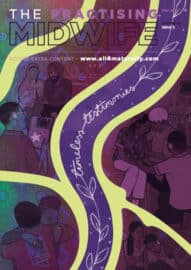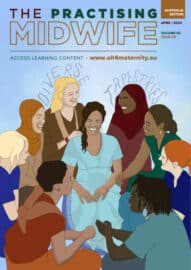Compassion as a Powerful Intervention: How the interactions between women, midwives and maternity services influence women’s childbirth experiences and subsequent trauma
Jenny Patterson – School of Health and Social Care, Edinburgh Napier University
Diane Ménage – Lecturer in Midwifery, De Montfort University, Leicester, England (formerly at Coventry University, England)
Published in The Practising Midwife Volume 23 Issue 8 September 2020 https://doi.org/10.55975/IAOD9019
Summary
This article combines work from two separate PhD research studies by Dr Jenny Patterson and Dr Diane Ménage. These studies explored, from different perspectives, how the nature of interactions between midwives and women may contribute to, or prevent, trauma. The findings are presented and discussed. Jenny and Diane argue that their joint findings add new insights and show that the compassion shown during interactions between midwives and women may be key to preventing experiences becoming traumatic for women and midwives. They uphold compassion as a vital human connection in midwifery care and the workplace culture as key to sustaining it.
Introduction
The whole is more than the sum of its parts.1
Two midwives independently carried out PhD research projects on different aspects of the experiences of midwifery care. Jenny Patterson researched women’s and midwives’ experiences related to traumatic births. Diane Ménage researched women’s experiences related to compassionate care. Both used a qualitative methodology called Interpretive Phenomenological Analysis (IPA) to elicit rich, meaningful data on participants’ unique experiences. IPA, now a well-established methodology for studying lived experience, draws on the philosophical principles of interpretive (or hermeneutic) phenomenology.2 Jenny and Diane did not know each other or about each other’s studies until they met at a conference near the end of their research. Later, when both had completed their research, they discussed their findings and realised that somehow, surprisingly and quite independently, their separate findings appeared to depict the same things. They had, in fact, been studying opposite sides of the story. This paper outlines both studies and argues that, together, their evidence provides important insights into the nature and impact of different interactions between women and midwives.
Summary of Jenny’s findings
Birth trauma and related Post-Traumatic Stress Disorder (PTSD) symptoms are distressing complications of the childbirth experience. For up to 45% of new mothers, their childbirth experience fulfils the clinical definition of trauma: ‘To have experienced or witnessed, actual or threatened, death or harm’.3,4 Furthermore, some women go on to develop full (4%) or partial (9-27%) Post-Traumatic Stress Disorder-Post Childbirth (PTSD-PC)5,6 with negative impacts on women, children, families and wider society. A woman’s perception of her interaction with her care providers is a significant factor in the development of Birth Trauma and PTSD-PC.7,8 Therefore, Jenny chose to hear both sides of the story of the lived experience of interacting during maternity care, from the perspective of women with full PTSD-PC and midwives.
Jenny’s findings9 found that the women and midwives all expressed the importance of and strong desire to ‘be with’ the other. This ‘being with’ encompassed relationship, communication and understanding individual needs, alongside a level of connection that enabled the provision and receipt of respectful care. Traumatic memories for the women frequently related to times when this ‘being with’ was non-existent, dysfunctional or became lost. Similarly, for the midwives, great distress arose when they were unable to ‘be with’ women in the way they desired, leaving them feeling that they were not fulfilling their role. When women and midwives did not experience ‘being with’ they described feeling abandoned or abandoning. This was most profoundly felt in the time directly after the birth of the placenta, when midwives were instructed to go to care for another woman. The midwives described this as the worst thing.
Key themes related to meeting basic human needs, especially to feel safe. The women described sometimes feeling directly threatened by midwives, either verbally or physically, leaving them fearful for themselves and their babies. They could not believe this was happening. Their (realistic?) expectations of being in a place of safety (hospital), in the hands of those who should be trustworthy, were shattered.
Women’s shattered expectations related not to the process of birth, but how they felt treated by those they expected to trust. For midwives, they described unrelenting workplace pressures, coupled often with undermining and unsupportive behaviour by colleagues. This left them feeling ‘torn in two’ between ‘being with’ women, meeting women’s needs and meeting the demands and expectations of the workplace and colleagues. Midwives also experienced a lack of personal or professional support in response to clinically challenging or traumatic events. These experiences can contribute to trauma and the development of PTSD for midwives, which is a significant concern affecting up to 33% of them.10 The term Sanctuary Trauma is equally applicable for both the women and the midwives:
In balance, most women find their interactions with midwives to be positive and affirming,12 and many do not develop birth trauma, and even less develop PTSD-PC. This is likely due to the amazing dedication of many midwives, who even in the face of clinical and organisational challenges remain ‘with woman’.
Summary of Diane’s findings

In contrast, Diane’s PhD examined women’s lived experience of receiving compassion from midwives.13 Women who self-identified as having had compassionate care from a midwife or midwives were interviewed about this experience. Arguably, the most striking theme was Women’s Need for Compassion, which supported the concept of compassion being a response to suffering.14,15 Women spontaneously described their experience of compassionate midwifery care in the context of emotional and physical vulnerabilities and difficulties around pregnancy and birth. This suffering most often related to fear and anxiety, but physical and emotional pain also featured widely. Importantly, the women told of how compassion from a midwife helped them to feel less fearful and more able to cope.
Three themes represented the ways in which women experienced compassion from midwives. ‘Being with’ reflected the feeling that there was something about the way that the midwife was with the woman that was at the heart of compassion. Being with was about being present, attentive and tuned in to the woman. Relationship encompassed the ways that midwives showed compassion within a relationship with the woman. This moved beyond the midwife’s attentive presence and involved the midwife and woman having an authentic interest in each other as people. The theme of Empowerment highlighted the ways in which women felt compassion from midwives through interactions that helped them to feel more empowered. These included giving information, teaching and coaching women in a non-authoritarian way. Women talked of midwives who empowered them by providing them with knowledge and skills while simultaneously being ‘on their side’ or ‘on the same level’. Furthermore, the theme of Balance came out of women’s ability to see very clearly how midwives have to balance different aspects of their work in order to interact in compassionate ways. Women not only identified midwives who managed to do this but also spoke of situations when midwives were unable to balance conflicting demands and therefore unable to show compassion.
The findings suggest that midwives are constantly trying to balance the organisational demands on them with quality, compassionate care for women. While the balance is successfully maintained, so is compassionate midwifery. However, it is a precarious balancing act at times. Once the balance is lost, then so is compassion.13
Parallels
Both studies point to the same thing from different angles.
Jenny’s study uncovered the reality of Sanctuary Trauma when a less than optimal interpersonal response is made towards women by those who are considered responsible for their wellbeing. Meanwhile, in Diane’s study, sanctuary in the face of suffering was experienced by women through compassionate care.
Both studies highlight the underlying essential human need for connection, respect, and to feel safe and supported.
A human experience, childbirth intensifies these needs. Childbirth creates particular vulnerability: psychologically; physically; and hormonally,13 alongside the potential for suffering, all compounded within the complex, risk-focused culture of modern maternity systems, which feed fear for both the woman seeking safety and the midwife responsible for maintaining safety.17
Essentially, high-quality compassionate interactions happen when midwives show a very human response in conjunction with their professional role. This very human response may be demonstrated in many different ways but was clearly epitomised in Diane’s study by the symbolism of tea. Offering, making and sharing tea for women and their partners highlighted how midwives used this ordinary, non-clinical action to show caring, as a friend or family member might do. This small act of ‘looking after’ appeared to echo a form of kinship that increased women’s feelings of connection, safety and normality, and had a calming and grounding effect. While tea has had some recognition within healthcare more widely,18 until recently there has been little empirical evidence of its place in midwifery care. Calls for a more humanised approach to childbirth19,20,21 support the idea that women using maternity services must be seen as unique human beings first and foremost. Therefore, culturally embedded rituals and symbols of human connection (like making tea) are important aspects of humanised care.
A deeper understanding of the role of interaction
These convergent findings are consistent with wider research highlighting the central role of the woman/midwife interaction.22 Whether this interaction constitutes a short-term connection or some level of relationship, the perceived experience of this interaction clearly influences a woman’s perception of her childbirth event.
Are midwives to blame?
On the face of it, a poor interaction in which women feel dismissed, chastised or ‘like a bother’ to the midwives,9 and do not find their midwives to be compassionate could be seen as poor behaviour by midwives. On the other hand, interactions that women experience as compassionate or where they develop a strong bond or relationship, even for a short time with their midwives, could be seen as a job well done by midwives. Either interpretation potentially places responsibility or even blame on the midwives. However, the reality is much more complex.
So, what contributes to the difference between compassionate and traumatic interactions?
Workplace context
The midwives Jenny interviewed were strongly motivated to create very positive experiences for women, within the context of keeping women and babies safe. This impassioned starting point is often expressed by midwives and student midwives.23 Yet, midwifery is a physically and emotionally demanding profession and midwives are at risk of work-related psychological distress, and the workplace environment and culture that midwives work within can have a big impact on midwives’ emotional wellbeing.24,25,26 A recent study from Cardiff University reported worrying levels of stress, burnout and depression amongst UK midwives.27 Moreover, NHS-employed clinical midwives were at much greater risk of emotional distress than midwives in other countries. When midwives are themselves suffering they have very limited ability to recognise and respond to the emotional needs of others. Therefore, this has very serious implications for the delivery of high-quality, safe maternity care. As a woman in Jenny’s study put it: ‘I dunno, there’s something wrong with a system that doesn’t allow you to be human.’
Workplace ideology: ‘Vigil of Care’ vs ‘Care as Gift’
Another angle to explore is the workplace culture and underlying ideologies of care that midwives work within. Much midwifery literature explores the tensions between the social and medical models of midwifery, both of which exist within the highly technocratic business model of NHS care.28,29 Reflecting on the concept of Sanctuary Trauma discussed above, it is suggested another layer of care ideology exists, referred to as ‘Vigil of Care’ (characterised by surveillance, authority, knowledge and power) and ‘Care as Gift’ (characterised by engagement, individualised response, generosity, and trust).30 Whether a woman is accessing a social or medical model of midwifery care, the provision of this care as ‘Vigil’ or ‘Gift’ concerns the interpersonal approach by the care provider. In a workplace context where ‘Vigil of Care’ is the cultural norm, this may contribute to midwives detaching themselves emotionally in order to administer the appropriate levels of monitoring and/or intervention deemed necessary. Jenny’s theme of being ‘torn in two’ (between the needs of women and demands of the system) often left midwives withdrawing from women just to cope. In contrast, ‘Care as Gift’ encompasses the compassionate interactions experienced by women in Diane’s study, where midwives found a way of maintaining affirming positive interactions. This may be because of a more conducive workplace culture, or due to more confidence and experience in working within less conducive environments, as a result of greater experience in the midwifery role or from life.
Positive interpersonal interactions are not extra
These studies highlight that positive interpersonal interactions between women and midwives during maternity care are not ‘optional extras’. The quality of these interactions is critical to the psychological wellbeing of both women and midwives. The highly prioritised physical outcomes are potentially being impacted too, since psychological wellbeing has a direct impact on physical birth processes and outcomes.16 Therefore, the status of psychological wellbeing should be placed equal to physical wellbeing. This would require maternity services to urgently address workplace cultures and conditions that negatively impact on midwives’ behaviours, leaving them unable to ‘be with’ women as they need and desire to. To ignore this, is to break the tenet of ‘first do no harm’.
Compassion is a powerful intervention
Compassionate midwifery is a powerful intervention that reduces women’s fears and anxieties and helps them feel more able to cope. The value of this for women at risk of birth trauma is evident. Recognition of compassion as a key midwifery tool should be demonstrated in all areas of midwifery practice, policy and education. Compassion, essentially, is about being human and professional at the same time.
Conclusion and implications for practice
Increased emphasis needs to be placed on how human connection can run alongside professional practice in midwifery education. This must be done through acknowledgement of midwives’ needs. Wagner,21 on writing about the humanisation of childbirth, emphasised the importance of seeing the woman as a human being. This is essential, but it cannot work without understanding that midwives are human too. The relationship between the expression of compassion from midwives and the balancing act that midwives must maintain in order to provide this sort of care needs to be understood and requires further study. The workplace culture and conditions that midwives work within are pivotal to the provision of compassionate care. Therefore, all those practising, managing and commissioning maternity care need to consider how they can take action to support midwives to provide compassionate midwifery care. TPM
Key statements from these joint findings:
- Compassionate midwifery has the potential to reduce birth trauma and associated PTSD-PC.
- The ‘Gift’ or ‘Compassionate’ components of midwifery care are fundamental to safe care.
- The status of psychological wellbeing needs must be placed as at least equal to physical wellbeing in order to drive forward essential change.
- Interpersonal skills must be acknowledged to be as important as clinical skills and taught and assessed accordingly.
- Toxic and damaging maternity workplace environments and cultures must be urgently addressed.
- Poor interpersonal behaviour by maternity staff at all levels must not be condoned and needs to be called out compassionately in recognition of the humanity of staff.
- There is no compassion in midwifery without you!
References
- Aristotle. Metaphysics. http://www.perseus.tufts.edu/hopper/text?doc=urn:cts:greekLit:tlg0086.tlg025.perseus-eng1:8.1045a. Accessed May 10, 2020.
- Smith J, Flowers P, Larkin, M. Interpretative Phenomenological Analysis Theory Method and Research. London: Sage; 2009.
- APA. Diagnostic and Statistical Manual of Mental Disorders. 4th ed. Washington, DC: American Psychiatric Association; 1994.
- Alcorn K, O’Donovan A, Patrick J, Creedy D, Devilly G. A prospective longitudinal study of the prevalence of post-traumatic stress disorder resulting from childbirth events. Psychol Med. 2010;40(11):1849-1859.
- Dekel S, Stuebe C, Dishy G. Childbirth induced posttraumatic stress syndrome: a systematic review of prevalence and risk factors. Front Psychol. 2017;8:560.
- Yildiz P, Ayers S, Phillips L. The prevalence of posttraumatic stress disorder in pregnancy and after birth: A systematic review and meta-analysis. J Affect Disord. 2017;208:634-645.
- Reed R, Sharman R, Inglis C. Women’s descriptions of childbirth trauma relating to care provider actions and interactions. BMC Pregnancy Childbirth. 2017;17:21.
- Patterson J, Hollins Martin C, Karatzias T. PTSD post-childbirth: a systematic review of women’s and midwives’ subjective experiences of care provider interaction. J Reprod Infant Psychol. 2018;37(1):56-83.
- Patterson J, Hollins Martin C, Karatzias T. Disempowered midwives and traumatised women: exploring the parallel processes of care provider interaction that contribute to women developing Post Traumatic Stress Disorder (PTSD) post childbirth. Midwifery. 2019;76:21-35.
- Toohill J, Fenwick J, Sidebotham M, Creedy D. Trauma and fear in Australian midwives. Women and Birth. 2018;31(1):64-71.
- Silver S. An Inpatient Programme for Post Traumatic Stress Disorder. In: Figley, C, ed. Trauma and Its Wake Volume II: Traumatic Stress Theory, Research, and Intervention. Levittown: Brunner/Mazel; 1986:213-231.
- Sorenson D, Tschetter L. Prevalence of negative birth perception, disaffirmation, perinatal trauma symptoms, and depression among postpartum women. Perspect Psychiatr Care. 2010;46:14-25.
- Ménage D, Bailey E, Lees S, Coad J. Women’s Lived Experience of Compassionate Midwifery: Human and Professional. Midwifery. 2020 Jun;85:102662.
- Gilbert P. The Compassionate Mind. London: Constable & Robinson; 2009.
- Ménage D, Bailey E, Lees S, Coad J. A Concept Analysis of Compassionate Midwifery. J Adv Nursing. 2017;73(3):558-573.
- Buckley S. Hormonal Physiology of Childbearing: Evidence and Implications for Women, Babies, and Maternity Care. https://www.nationalpartnership.org/our-work/resources/health-care/maternity/hormonal-physiology-of-childbearing.pdf Published January 1, 2015. Accessed May 11, 2020.
- Scamell M, Stone N, Dahlen H. Risk, Safety, Fear and Trust in Childbirth. In: Downe S, Byrom S, eds. Squaring the Circle: Normal Birth Research, Theory and Practice in a Technological Age. London: Pinter & Martin; 2019:100-107.
- Chinn T. Evidence Based Tea. Teresa Chinn. http://teresachinn.co.uk/evidence-based-tea/ Published Nobember 29, 2017. Accessed January 10, 2020.
- Page L. From Medicalisation to Humanisation. Br J of Midwifery. 2016;24(10):682.
- Newnham E, Mckellar L, Pincombe J. Towards the Humanisation of Birth: A Study of Epidural Analgesia and Hospital Birth Culture. London: Palgrave Macmillan; 2018.
- Wagner M. Fish can’t see water: the need to humanize birth. Int J Gynaecol Obstet. 2001;75:S25-S37.
- Kirkham M. The Midwife-Mother relationship. Hampshire: Palgrave Macmillan; 2010.
- Davies S, Coldridge L. Trauma experienced by student midwives. In: Edwards, N, Mander R, Murphy-Lawless J, eds. Untangling the Maternity Crisis. Abingdon: Routledge; 2018:51-58.
- Cramer E, Hunter B. Relationships between working conditions and emotional wellbeing in midwives. Women and Birth. 2018;32(6):521-532.
- Geraghty S, Speelman C, Bayes S. Fighting a losing battle: Midwives experiences of workplace stress. Women and Birth. 2019;32(3):e297-e306.
- Pezaro S, Clyne W, Fulton E. A systematic mixed-methods review of interventions, outcomes and experiences for midwives and student midwives in work-related psychological distress. Midwifery. 2017;50:163-173.
- Hunter B, Henley J. Work, Health and the Emotional Lives of Midwives in the United Kingdom. Royal College of Midwives. https://www.rcm.org.uk/media/2924/work-health-and-emotional-lives-of-midwives-in-the-united-kingdom-the-uk-whelm-study.pdf. Published January 1, 2017. Accessed Mar 2, 2020.
- Kirkham M. Fundamental Contradictions. In: Edwards N, Mander R, Murphy-Lawless J, eds. Untangling the Maternity Crisis. Abingdon: Routledge; 2018:75-84.
- Downe S, Byrom, S, eds. Squaring the Circle: Normal birth research, theory and practice in a technical age. London: Pinter & Martin; 2019.
- Walsh D. Nesting and Matrescence. In: Bryar R, Sinclair M. eds. Theory for Midwifery Practice. 2nd ed. Basingstoke: Palgrave MacMillan; 2011:178-196.









